Even if it is clean, a stained bathroom never actually looks or feels clean, particularly if those stains are yellow or brown! And when these colors are dripping down the walls…well, its definitely something you want to get to the bottom of.
There are a couple of potential causes of these discolored droplets, the most common of which revolve around excess moisture. Others include heat exposure or residue building up on the walls. Happily, all the issues have pretty simple solutions to get your bathroom looking fresh again in no time.

Minerals, mildew, heat damage, soot, soap, and cigarette smoke can cause wall discoloration, which can be picked up by condensation. The result is a yellow/brown sweat-like occurrence. The yellow/brown marks can be removed with scrubbing and an acid cleaner. New paint can cover heat damage and tough stains.
The Moisture Comes From Condensation
If you have water droplets forming on and running down your bathroom walls, you may have already guessed that condensation is your issue. After all, it’s not an uncommon occurrence in a bathroom.
Condensation forms when the hot, moisture-laden steam created by running a hot shower or bath comes into contact with the comparatively cold surfaces in the bathroom.
The thermal energy in the air is transferred down the temperature gradient to the colder surfaces. When this happens, the air molecules stop moving so fast, allowing them to stay closer to one another.
This means that there is less space for water molecules to fit between the air molecules and water is forced out as condensation.
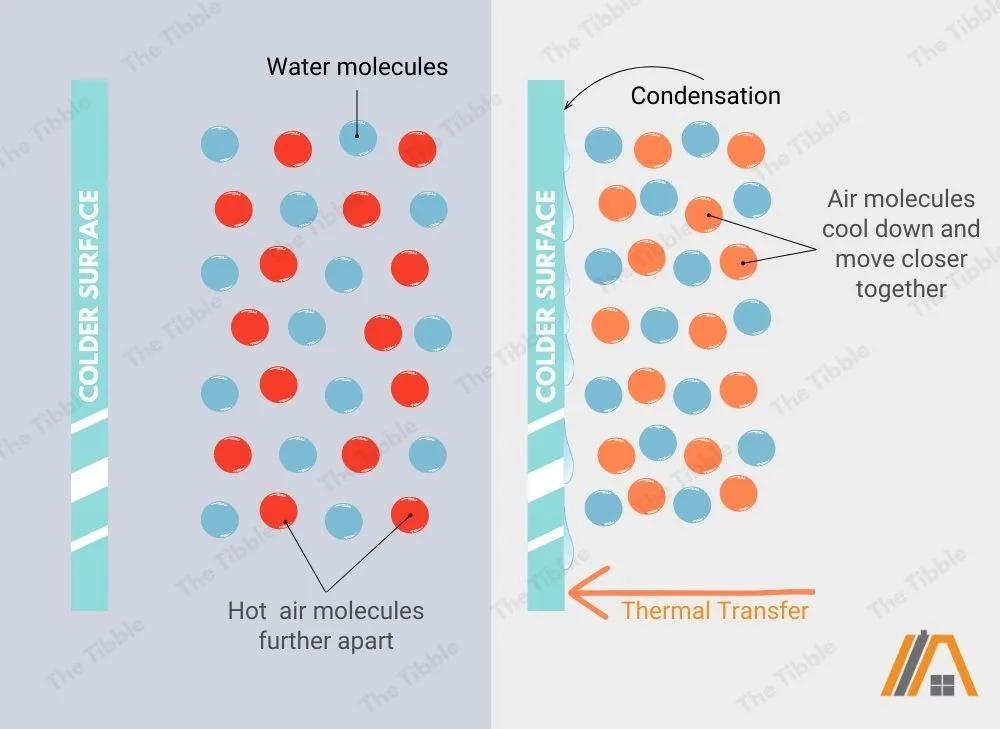
So, the condensation is not abnormal, although high levels and long drying times are problematic. The question here is, why are these droplets yellow/brown?
Minerals in the Water
One reason the condensation takes a yellow/brown hue is due to the composition of the water itself.
I doubt it’s news to you that you are not getting perfectly distilled water coming out of your faucets and showers. There are always other substances present, suspended in the water.
These can be natural minerals from wells or boreholes or artificial minerals from treated municipal water.
However, the type and amount of minerals can vary depending on the source of the water or even the municipal area in which you live.
This is why you may not have had this problem at your previous home and why you may not have it at your next.
Things like iron, manganese, and tannins (organic matter) can turn water yellow or brown.
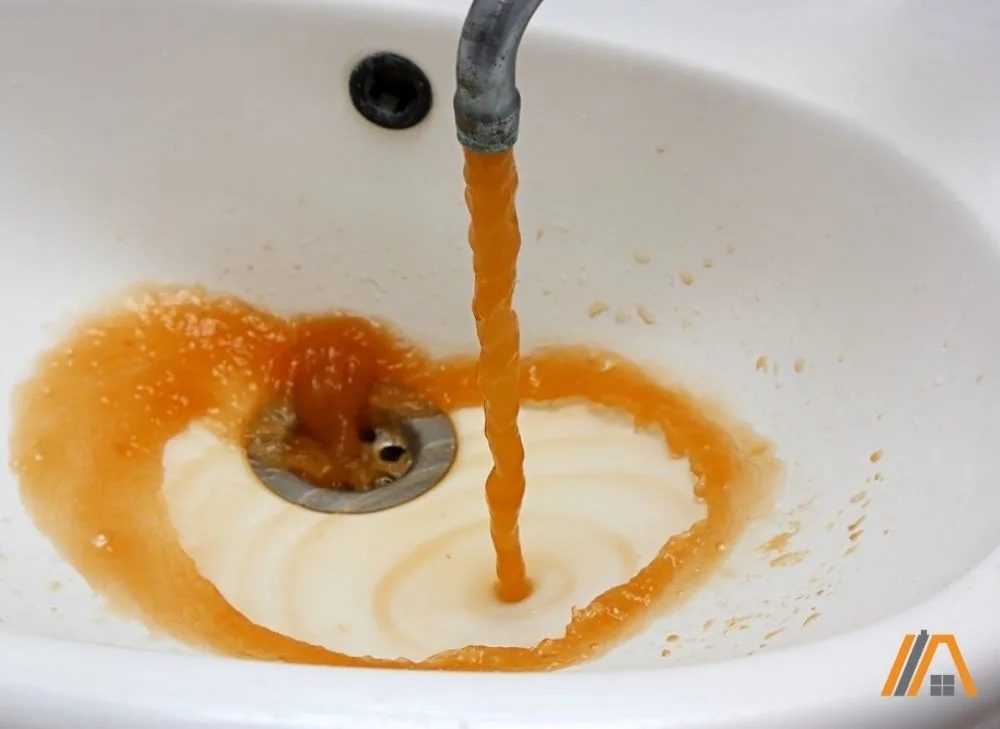
Sometimes, you will notice this discoloration in the running water, but most often, it’s too light in color when coming out of your taps.
However, when condensation dries on the surfaces in your bathroom, it leaves these substances behind as deposits, which can then build up.
Over time, the new condensation picks up the built-up residues, which colors the water a noticeable yellow or brown color.
Unfortunately, the minerals are just redeposited as the new condensation evaporates and the minerals that were already in that water are also deposited onto the walls, furthering the problem.
Condensation Can Also Cause Yellow Mildew
Mildew is a type of fungus that loves a warm and moist environment, which is exactly the environment provided by your bathroom.
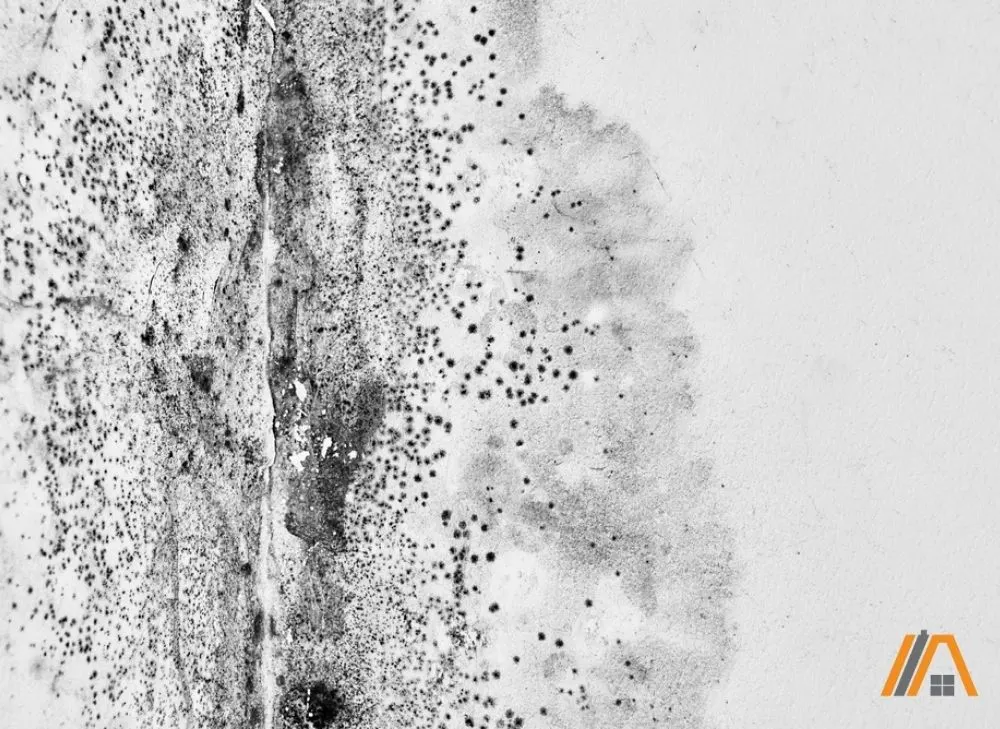
Mildew comes in a variety of colors, including brown and yellow. Yellow is the most common color you will see in a bathroom.
As with mineral deposits, the discoloration of condensation as a result of mildew growth is not going to be apparent at first. I mean, mildew doesn’t start growing after one steamy shower.
An exception would be if you moved into a house with old bathrooms that already have mildew growing on the walls.
It’s the mildew itself that lends color to the water droplets, so only once mildew is growing will your walls appear to sweat yellow/brown.
Condensation glistening on top of mildew can make the water look yellow/brown, but in these cases, you are more likely going to be focusing on the actual mildew growing on the walls.
However, mildew spores can be picked up by the condensed water and drip down onto walls that are not obviously mildew-covered. The spores lend a tinge of color to the water, which can appear yellow/brown.
Perhaps these spores are being picked up from places that are less visible, e.g., the ceiling where it’s covered by the light fitting or the wall hidden by a storage unit or the toilet cistern.
So, don’t just write off this possibility if you don’t initially see any mildew.
Heating Appliances Can Cause Wall Discoloration
Sources of heat can also be the cause for the yellow/brown sweat. Here, we are not talking about hot water.
Rather, we’re referring to bathroom heaters, heated towel rails, water heaters (some people have the space to keep these in the bathroom), and even dryers that are installed in the bathroom.
White paint can be readily discolored by prolonged exposure to heat. The paint starts to break down and can turn a shade of yellow. It may even start to crack or marble, like an old statue.
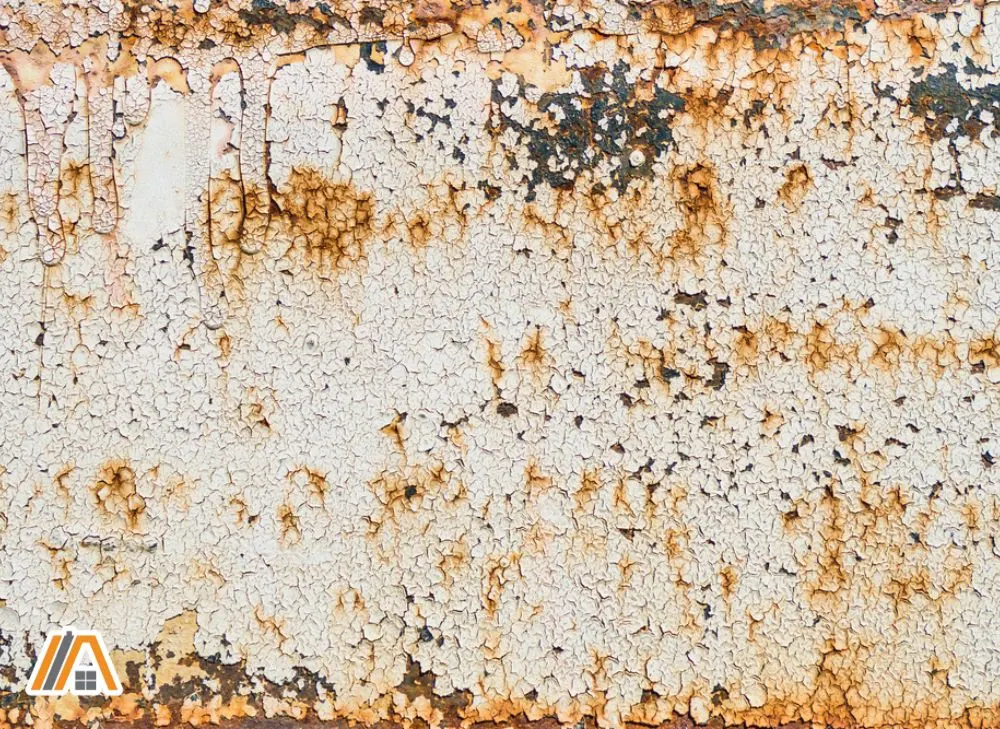
Even if excessive condensation is not a problem in your bathroom, i.e., your ventilation system is doing its job, there will still be some water droplets forming on the the walls. These can pick up the color leaching from your paint and appear as yellow sweat.
In some cases, the heat don’t compromise the paint. Instead, the actually heating process results in the emission of various by-products and soot, which can mix with the steam in the air and/or coat the walls.
The water discolors as it picks up these particles before or after condensing on the walls.
Soap Stains Can Look Yellow
Despite being the go-to product for cleaning, soap can actually become a source of dirt.
This happens when the soap residue builds up in a bathroom. This residue is known as soap scum and it has a filmy appearance.
Not only can the soap be yellow or off-white in color, but it can also catch dirt and turn yellow/brown.
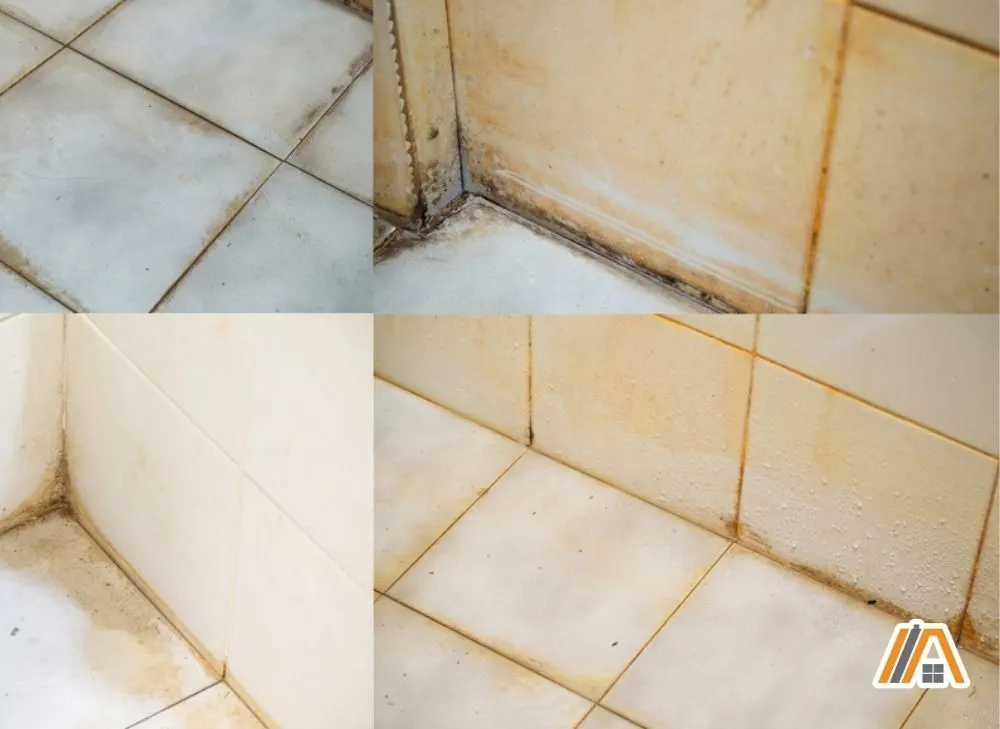
Water condensing on walls can pick up this scum, carrying it down the wall as yellow/brown sweat-like drips.
This seems to be more problematic with less natural soaps and soaps that foam very well.
An Alternative Explanation: Cigarette Smoke
As most people know, cigarette smoking is not a healthy habit, and you hear stories of blackened lungs and stained fingers and teeth.

Well, just as the nicotine- and tar-filled smoke of cigarettes can cause the fingers and teeth of chronic smokers to turn yellow or brown, so too can it affect the walls in your home.
One of my relatives recently moved into an apartment that had been occupied by a smoker. She spent weeks scrubbing the walls and ceilings, pouring countless buckets of yellow water down the drain per wall and section of the ceiling.
The presence of an extractor fan often leads smokers to smoke in or near their bathrooms when they are not able to access an outside area or if it is too cold or wet to open a window.
Alternatively, when the extractor fan is turned on, it will pull in a “fresh” air supply from adjoining rooms. In a chronic smoker’s house, this air is likely to contain cigarette smoke, and the bathroom walls are thus exposed, even if the cigarette was not smoked in the bathroom itself.
When the bathroom walls are perpetually bombarded with the tainted smoke, the particles settle onto the surfaces, and over time, the buildup will become more and more noticeable as a yellow/brown stain.
As most bathroom walls are painted in light colors, this discoloration is going to become obvious quite soon.
When condensation settles over the stains, it can look like the walls are sweating yellow, either by magnifying the discoloration or by picking up and carrying the yellow residue.
Cleanup Solutions
Getting Rid of Mineral Deposits and Soap Scum
If you have yellow/brown mineral deposits or a buildup of soap scum, you should be able to clean these off the walls with basic cleaning techniques.
Some mineral stains will be harder to get rid of than others. It depends on the minerals being deposited, the amount, and how long they’ve been caked to the walls.
Soap scum should be pretty easy to clean off, but if it leaves behind stains, then these can take a little more effort to eliminate.
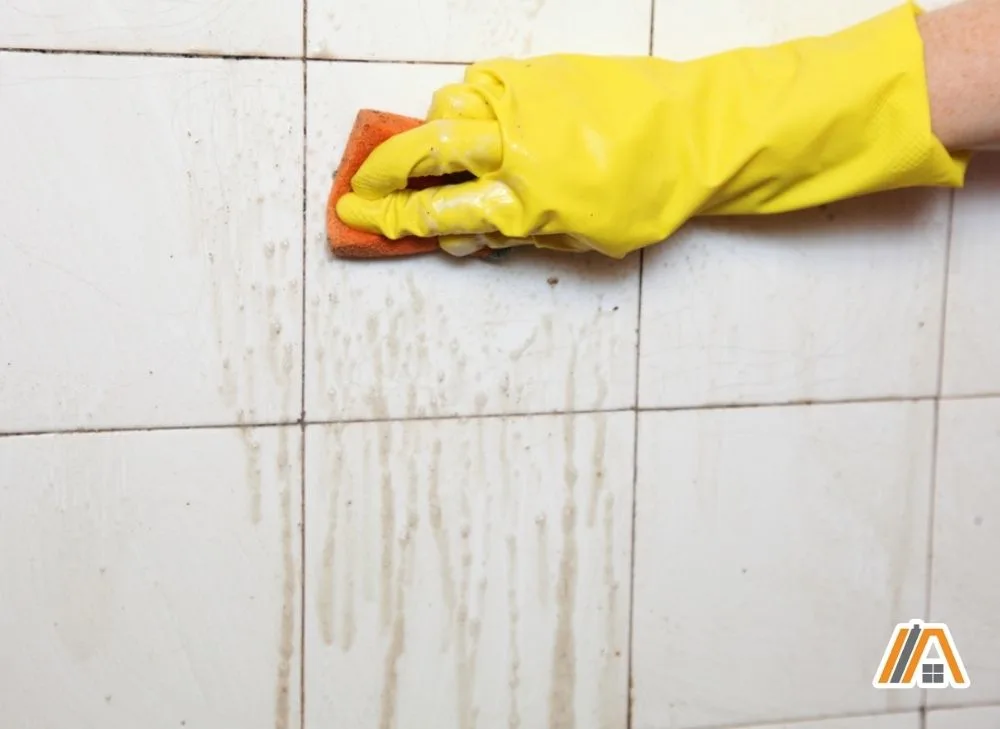
Start by gently scrubbing the wall with a soft-bristled scrub brush. The minerals or soap scum may come off like dust if it’s dried.
If you don’t seem to be winning, you may benefit from applying clean water or a formulated cleaning liquid to loosen the yellow particles.
Cleaning products also contain substances that are specifically designed to lift stains, which can save you some elbow grease.
If you need to, you can bring out the “big guns”, a.k.a., bleach. However, you have to be careful because if you use a solution that is too strong, you will end up further staining your walls yellow.
Make sure you’ve already cleaned the walls as well as possible. Mix one cup of bleach and a gallon of water inside of a bucket. Dip a clean sponge into the mixture (wearing gloves to protect your hands!) and wipe down the yellow surfaces with it. You should start to see the yellow change color.
You can also use a razor blade to scrape the soap scum off of the walls.
Bleach and a soft-bristled brush are also excellent at clearing up yellow toilet stains. So, if your toilet is matching your walls—and not in a good way—then tackle these stains as well to get your bathroom looking new.
Removing Mildew
With mildew, you have to get every last spore in order to prevent it from growing back.
The best way to tackle mildew is with a scrub brush and either vinegar or bleach.
The either/or specification is crucial. Mixing vinegar and bleach together can lead to the production of chlorine gas.
Chlorine gas is corrosive, burning the mucous membranes, eyes, and respiratory tract when inhaled. When your respiratory tract gets burned, it produces swelling known as edema, which can constrict your airways.
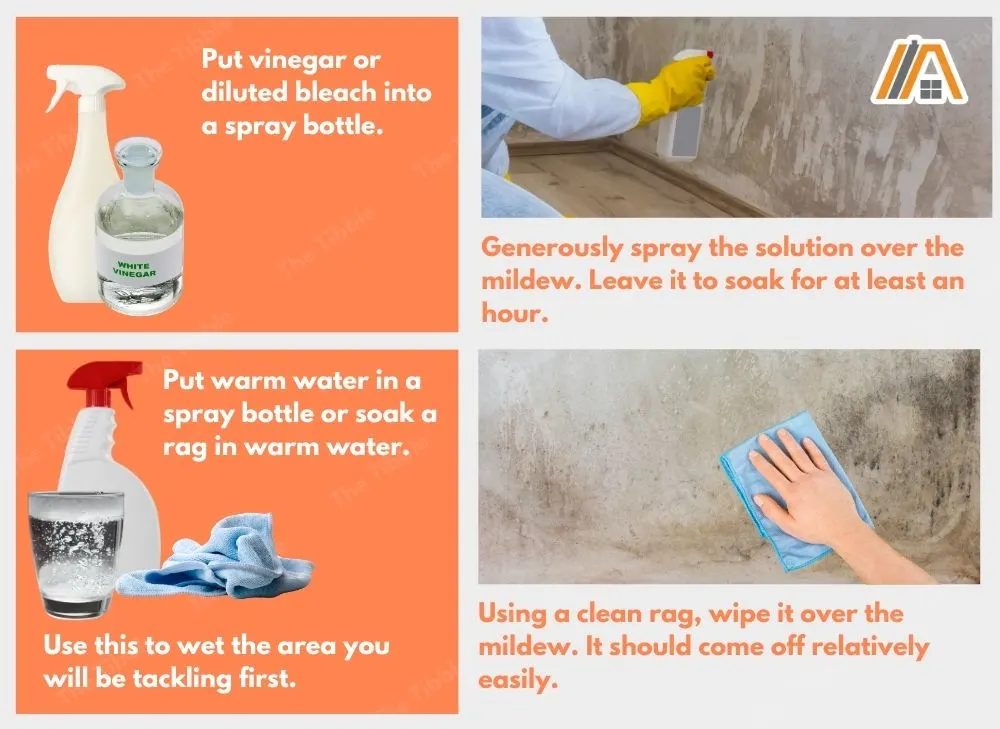
But don’t be afraid of using either vinegar or bleach as per the following method:
- Put vinegar or diluted bleach into a spray bottle, and generously spray the solution over the mildew.
- Leave it to soak for at least an hour.
- Put warm water in a spray bottle or soak a rag in warm water. Use this to wet the area you will be tackling first.
- Using a clean rag, wipe it over the mildew. It should come off relatively easily. If it doesn’t you can put a bit of force behind your wiping or you can switch to a more abrasive tool like a brush.
- Make sure the area is dried afterward.
Address Heat Damage and Soot
You can use the cleaning methods mentioned in the previous sections to get rid of soot from the walls.
However, if your paint has been damaged by heat, your best bet is to repaint the walls.
Some tips to make this successful:
- Sand the old paint down first to remove and flakes that would compromise the new layer.
- Clean the wall and allow it to dry before repainting.
- Paint the entire bathroom. If you just paint the damaged spot or wall, the chances are good that you will end up with a patch that looks different to the rest of the room.
- Use a bathroom paint.
Cleaning Up Smoke Stains
Cigarette smoke stains can be removed using warm white vinegar. For dark stains, use it neat or undiluted; for minor stains, you can mix up equal parts warm water and vinegar.
It is important for you to use warm vinegar (or vinegar solution) because the yellow stains caused by cigarettes can become sticky or hardened.
Alternatively, you may be able to remove the cigarette stains using a household detergent, preferably one designed to combat grease, such as a dishwashing liquid.
This method is particularly effective if you invested in a high-gloss bathroom-specific wall paint.
If the degreasing detergent is not working effectively on its own, you can try adding some baking soda.
- The quantities would be 0.5-0.7 fl. oz. (15-20 ml) of detergent and approximately half a cup of baking soda for every gallon of water you use.
Removing stains will also always involve time and elbow grease, so don’t get disheartened if it takes a while or even a few cleaning sessions to see significant results.
Prevention Tips
Once you have your walls all nice and clean again and that pesky yellow/brown “sweat” has stopped forming, you need to look at how to prevent the situation from happening again.
Preventing/Controlling Condensation
Bathroom Exhaust Fan
A bathroom exhaust fan that vents to the outdoors is by far the best method of keeping the humidity levels in check and, in turn, preventing excessive condensation from forming on the walls.
Be sure to size the fan and duct correctly—it’s more important than you might think.
A fan that is underpowered will struggle to exhaust the moisture fast enough, and an over-powered fan will require makeup air to prevent depressurization.
If you want to make things as easy as possible install the Panasonic fan pictured below. It is adjustable from 80-110 CFM and will be suitable for 90% of the bathrooms in the US.
- This bathroom vent fan features a low profile can ideal for residential construction; ceiling or wall mount
- This bathroom ceiling fan delivers quiet, powerful, and precise spot ventilation while removing moisture and pollution
- Built-in Pick-A-Flow airflow selector allows you to select an airflow of 50, 80, or 100 CFM for your vent fan with the flip of a switch
- With a 3-3/8-Inch housing depth, the WhisperValue DC is the slimmest bathroom exhaust fan design available
Last update on 2024-03-27 / Affiliate links / Images from Amazon Product Advertising API
Dehumidifier
Dehumidifiers are handy appliances to have for humid indoor environments.
Sometimes, domestic dehumidifiers are overwhelmed by the amount of moisture generated in a bathroom, but you can get ones that have a greater capacity. Besides, something is better than nothing.
- ➤【HIGH EFFICIENT DEHUMIDIFICATION】SEAVON portable dehumidifier with 35oz(1000ml) capacity tank extracts up to 16oz(450ml) of water daily in a humid environment of 86°F and 80% RH. With powerful...
- ➤【COLORFUL NIGHT LIGHTS & AUTO SHUT OFF】Our electric dehumidifier has 7 changing lights (which could be set steady), this bedroom dehumidifier creates a sweet and romantic sleeping atmosphere...
- ➤【TWO WORKING MODES & ULTRA QUIET】The dehumidifier is designed with high speed and low speed that meet all kinds of dehumidification requirements of different people. You can freely switch...
- ➤【SPACE SAVING & PORTABLE】This small dehumidifier has a cylindrical design and small size(6.3x6.3x10 inches). It also built-in handle and is easy to carry and relocate. Perfect for helping you...
Last update on 2024-03-27 / Affiliate links / Images from Amazon Product Advertising API
Open the Door or Window
If you have the option to open a bathroom window during your showers and baths, then take advantage of that option. It is a simple way to release moisture from your bathroom and avoid letting it sit on your walls.
Not all bathrooms have windows, but they will have doors. So, if you don’t have a bathroom window, you’ll have to keep the bathroom door open during or immediately following your shower or bath.
If the warm air can escape the bathroom through an open door, it can be almost as effective as an open window.
Wipe Down Everything
Use a dry towel to wipe off the condensation and water droplets from the surfaces of your bathroom. Ensure every surface is dry, including the walls, shower stall, windows, doors, countertops, and cabinets.
It will be extra work to dry everything manually, but it is better than being forced to clean mineral deposits and mildew off of your bathroom surfaces.
If you have a small bathroom, it should not take that much time to dry everything.
When I take a shower, I use a squeegee similar to the one below to get the majority of the water off of the walls and door. You can do this for all of the walls and catch the water at the bottom of the walls with a towel.
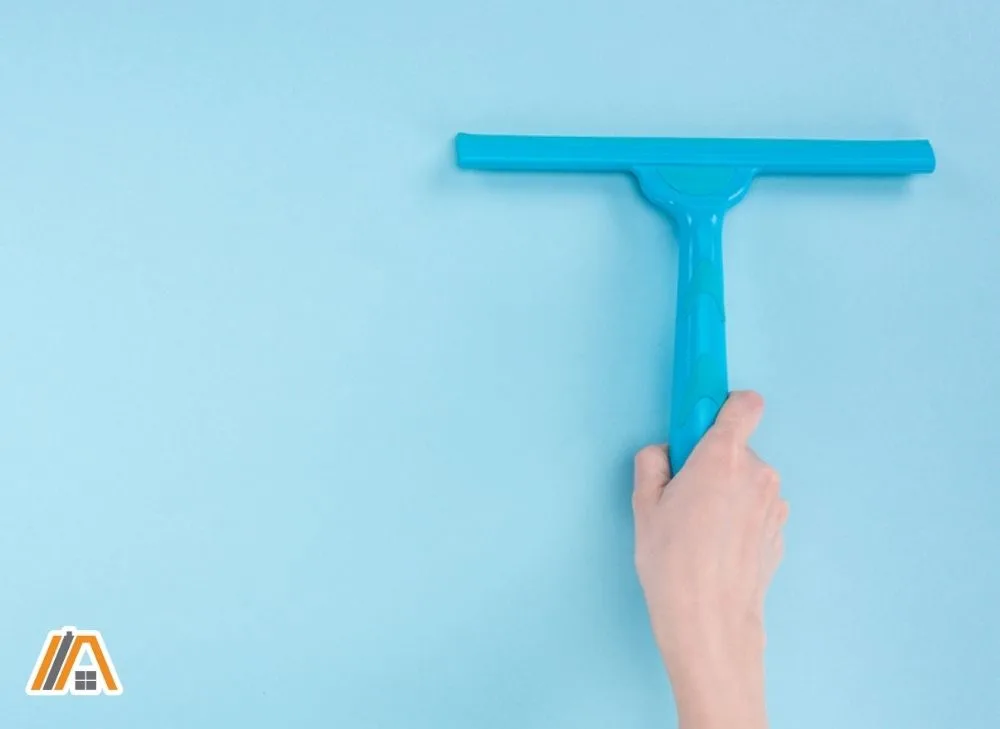
Don’t forget to dry the towels outside of the bathroom. Otherwise, all that moisture is just going to evaporate back into the air, available to condense on the walls again.
Take Cool/Shorter Showers and Baths
Yes, a long, hot shower is lovely after a long day of stressful work or as a way to warm up in winter.
However, if you are trying to prevent yellow/brown condensation, then you will either have to turn down the temperature or take shorter showers.
Mildew is a product of excessive condensation, so you can also check out the tips detailed in my article on preventing mold growth in bathrooms.
Preventing Heaters From Causing Problems
If you can, make sure that the heating device is further away from the wall when you use it.
You can also look into alternative heating methods if your device produces soot or other by-products.
You can get heat-resistant paints, which can help to prevent the degradation of the paint near the appliance.
Prevent Soap Buildup
So many retail soap products contain unnatural chemicals and ingredients, which could discolor your walls if they were to splash onto them.
Try instead to use less foamy soaps; ones with natural oils in them.
In addition, if you make sure that you wipe the residue off of the walls frequently, you can prevent it from getting to be that gross color.
Preventing Smoke Stains
While smoking is a difficult habit to overcome, many have done so, and it will certainly have more important rewards than a yellow stain-free wall.
However, not everyone is in a place to make a life change like this. For chronic smokers who cannot confine their smoking to outside areas only, you should clean your walls using one of the methods detailed in the cleaning section once or twice a week.
If the smoke is coming into your bathroom from a neighboring apartment then there are multiple easy solutions to that as well.
All of the above causes of yellow/brown spots on bathroom walls can also result in discolored ceilings. So, your problem can end up consuming the bathroom unless you permanently address the cause.


